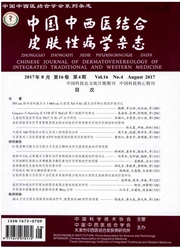

 中文摘要:
中文摘要:
<正>Objective:To observe the clinical efficacy of Chinese medicine(CM) treatment of Hongyou Ointment(红油膏) and Shengji Powder(生肌散) on diabetic ulcers,and to observe the influence of CM treatment on the expressions of proteins associated with the Wnt signaling pathway,such asβ-catenin,c-myc and K6.Methods:sixty-two patients fitting the registration standards were randomly divided into the CM group(31 patients) and the Western medicine(WM) group(31 patients) by a random number table.The patients in the CM group were treated with Hongyou Ointment and Shengji Powder externally.The patients in the WM group were treated with mupirocin ointment,growth factor(bFGF),and Vaseline gauze for external use and with basic therapies.Wound-healing time and four-week healing rate were recorded.The wounds were measured by digital photography and ImageJ software.Skin biopsies were obtained from 24 patients before CM treatment and 20 patients after CM treatment.Immunohistochemical tests and semi-quantitative imaging with NIH ImageJ 1.42 software were used to analyze the changes in protein expression ofβ-catenin,c-myc,and K6.Results:Fifty-three patients completed the trial;four patients in the CM treatment group and five patients in the WM group dropped out.Among them,four were dissatisfied with the treatment process,two could not continue because of their jobs,two failed to complete the course of follow-up appointments,and one was diagnosed with squamous cell carcinoma during treatment.The comparison of ulcer healing rates between the two groups showed insignificant differences(P=0.77).The ulcer healing rates were 33.33%(9/27) in the CM group and 26.92%(7/26) in the WM group.However,the effective rate was significantly higher in the CM group(81.48%,22/27) than in the WM group(57.69%,15/26,P=0.04).The mean wound healing time was shorter in the CM group(22.71±5.46 days) than in the WM group(26.56±7.56 days,P=0.04).CM treatment was well tolerated,and there was no withdrawal due to adverse reactions.Immunohistochemical an
 英文摘要:
英文摘要:
Objective:To observe the clinical efficacy of Chinese medicine(CM) treatment of Hongyou Ointment(红油膏) and Shengji Powder(生肌散) on diabetic ulcers,and to observe the influence of CM treatment on the expressions of proteins associated with the Wnt signaling pathway,such asβ-catenin,c-myc and K6.Methods:sixty-two patients fitting the registration standards were randomly divided into the CM group(31 patients) and the Western medicine(WM) group(31 patients) by a random number table.The patients in the CM group were treated with Hongyou Ointment and Shengji Powder externally.The patients in the WM group were treated with mupirocin ointment,growth factor(bFGF),and Vaseline gauze for external use and with basic therapies.Wound-healing time and four-week healing rate were recorded.The wounds were measured by digital photography and ImageJ software.Skin biopsies were obtained from 24 patients before CM treatment and 20 patients after CM treatment.Immunohistochemical tests and semi-quantitative imaging with NIH ImageJ 1.42 software were used to analyze the changes in protein expression ofβ-catenin,c-myc,and K6.Results:Fifty-three patients completed the trial;four patients in the CM treatment group and five patients in the WM group dropped out.Among them,four were dissatisfied with the treatment process,two could not continue because of their jobs,two failed to complete the course of follow-up appointments,and one was diagnosed with squamous cell carcinoma during treatment.The comparison of ulcer healing rates between the two groups showed insignificant differences(P=0.77).The ulcer healing rates were 33.33%(9/27) in the CM group and 26.92%(7/26) in the WM group.However,the effective rate was significantly higher in the CM group(81.48%,22/27) than in the WM group(57.69%,15/26,P=0.04).The mean wound healing time was shorter in the CM group(22.71±5.46 days) than in the WM group(26.56±7.56 days,P=0.04).CM treatment was well tolerated,and there was no w
 同期刊论文项目
同期刊论文项目
 同项目期刊论文
同项目期刊论文
 Effects of External Application of Chinese Medicine on Diabetic Ulcers and the Expressions of beta-c
Effects of External Application of Chinese Medicine on Diabetic Ulcers and the Expressions of beta-c 期刊信息
期刊信息
